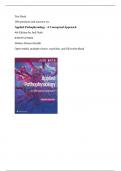Test Bank
160 questions and answers on:
Applied Pathophysiology - A Conceptual Approach
4th Edition by Judi Nath
9781975179205
Wolters Kluwer Health
Open-ended, multiple-choice, true/false, and fill-in-the-blank
,Contents
Open Questions (40)................................................................................2
Multiple Choice (30).................................................................................8
Multiple Choice (30 more in depth)........................................................13
True/False Questions (30).......................................................................18
Fill-in-the-Blank Questions (30)..............................................................21
Open Questions (40)
1. What is pathophysiology, and why is it important in the
study of medicine?
Answer: Pathophysiology is the study of the functional changes that
occur in the body because of disease or injury. It is important
because understanding these changes helps in diagnosing and
treating diseases.
2. Describe the role of inflammation in the body’s immune
response.
Answer: Inflammation is a protective response by the body to
harmful stimuli, such as pathogens or injury. It involves immune
cells, blood vessels, and molecular mediators to restore tissue
homeostasis.
3. What is the difference between acute and chronic
inflammation?
Answer: Acute inflammation is a short-term response to injury or
infection, typically characterized by redness, heat, swelling, and
pain. Chronic inflammation is a prolonged response that can lead to
tissue damage and is often associated with diseases like arthritis or
cardiovascular disease.
4. Explain the concept of cellular adaptation and provide
examples.
Answer: Cellular adaptation refers to the changes a cell undergoes
in response to stress, such as hypertrophy (increase in size),
atrophy (decrease in size), hyperplasia (increase in number), or
metaplasia (change in type).
5. How does ischemia lead to tissue injury?
Answer: Ischemia is a reduced blood supply to tissues, leading to a
lack of oxygen and nutrients, which results in cellular injury,
swelling, and, if prolonged, necrosis.
, 6. What is apoptosis, and how does it differ from necrosis?
Answer: Apoptosis is programmed cell death, which is a controlled
and regulated process. Necrosis, on the other hand, is unregulated
and results from severe cell injury, causing inflammation.
7. Describe the role of free radicals in cell injury.
Answer: Free radicals are unstable molecules that can damage
cellular components like DNA, lipids, and proteins, leading to
oxidative stress and cell injury.
8. What are the main types of necrosis, and how do they differ?
Answer: The main types of necrosis include coagulative,
liquefactive, caseous, and fat necrosis. Coagulative necrosis
involves cell membrane injury and protein denaturation, while
liquefactive necrosis involves enzyme breakdown of tissue, and
caseous necrosis is seen in tuberculosis.
9. What is the significance of the blood-brain barrier in
pathophysiology?
Answer: The blood-brain barrier is a selective permeability barrier
that protects the brain from harmful substances in the blood. Its
dysfunction can lead to neurological disorders or infections.
10. How do genetic mutations contribute to the
development of disease?
Answer: Genetic mutations can lead to abnormal protein function or
structure, disrupting normal cellular processes, which can
contribute to diseases such as cystic fibrosis, sickle cell anemia, and
cancer.
11. Explain the role of the immune system in autoimmune
diseases.
Answer: In autoimmune diseases, the immune system mistakenly
attacks the body’s own tissues, leading to inflammation and
damage. Examples include rheumatoid arthritis and lupus.
12. What are the differences between primary and
secondary immune deficiencies?
Answer: Primary immune deficiencies are genetic disorders
affecting the immune system, while secondary immune deficiencies
are acquired conditions, such as those caused by infections like HIV.
13. Describe the mechanisms of pain perception.
Answer: Pain is perceived through nociceptors, which are
specialized nerve endings that detect harmful stimuli. These signals
are transmitted to the brain via spinal cord pathways, where they
are processed as pain.




